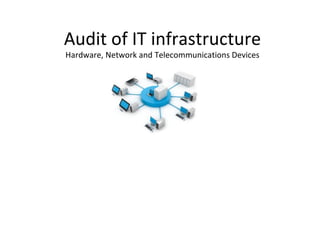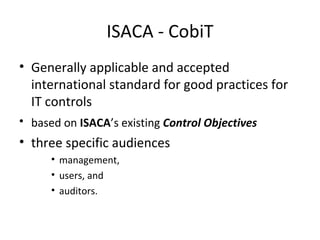Audit of it infrastructure
- 1. Audit of IT infrastructure Hardware, Network and Telecommunications Devices
- 2. What is IT Audit Examination of the controls within an Information technology (IT) infrastructure. Process of collecting and evaluating evidence of an organization's IT infrastructure. Understanding and evaluating each control. Assess compliance. Substantiate the risk of controls not being met.
- 3. Why IT Audit? Ensuring servers to be properly configured for both efficiency and security. Looking for hardware specific productivity drains. Obtain an asset listing of all hardware. L ooking for causes of frequent problems. E nsuring backup systems are adequate, monitored, tested regularly. Determining risks to information assets. Assessing controls in order to reduce or mitigate these risks.
- 4. Objectives of IT Audit? Continuity (consistent reliability and availability of system -- back-up and ability to recover) Management and Maintenance (additions, change procedures, upgrades, and documentation) Security (appropriate physical and logical access to network devices and hosts)
- 5. Perspectives of IS Audit
- 6. ISACA - CobiT Generally applicable and accepted international standard for good practices for IT controls based on ISACA ’s existing Control Objectives three specific audiences management, users, and auditors.
- 7. ISACA - CobiT provides detailed Audit Guidelines for auditors to follow in performing information systems audits Audit Guidelines provide a complementary tool to enable the easy application of the Framework and Control Objectives within audit activities objectives of auditing provide management with reasonable assurance that control objectives are being met where there are significant control weaknesses, to substantiate the resulting risks Advise management on corrective actions needed
- 8. ISO:IEC 27001 2005 International Organisation for Standardization International Electrotechnical Commission Provided a model for Establishing Implementing Operating Monitoring Reviewing and Improving Information Security Management System
- 9. ISO:IEC 27001 2005 PDCA model Plan Establish ISMS Do Implement and Operate Check Monitor and Review Act Maintain and improve
- 10. ISO:IEC 27001 2005 Control Objectives Control The policies, procedures, practices and organisational structures designed to provide reasonable assurance that business objectives will be achieved and undesired events will be prevented or detected and corrected Control Objective A statement of the desired result or purpose to be achieved by implementing control practices in a particular IT activity
- 11. ISO:IEC 27001 2005 Control The information security policy is being reviewed at planned intervals or if significant changes occur to ensure its continuing suitability, adequacy, and effectiveness. Review of the information security policy A.5.1.2 Control An information security policy document has been approved by management, and published and communicated to all employees and relevant external parties. The latest version of this document is available for all employees on the ABC Company’s internal network. Information security policy document A.5.1.1 A.5.1 Information security policy Objective: To provide management direction and support for information security in accordance with business requirements and relevant laws and regulations. A.5 Security policy
- 12. ISO:IEC 27001 2005 Control Rules for the acceptable use of information and assets associated with information processing facilities are identified, documented, and implemented. Acceptable use of assets A.7.1.3 Control All information and assets associated with information processing facilities are ‘owned’ by a designated part of the organization. Ownership of assets A.7.1.2 Control All assets are clearly identified and an inventory of all-important assets drawn up and maintained. The Classification of Assets is as per the guidelines laid out in Procedure on Risk Assessment. Rules of classification take asset value and importance into account. A list of assets including the owner and relevant details is kept with the respective functional departments. Additional asset details are maintained by the Admin Department for the purposes of audit and keeping track of assets. Inventory of assets A.7.1.1 A.7.1 Responsibility for assets Objective: To achieve and maintain appropriate protection of organizational assets. A.7 Asset management
- 13. Information Systems Hardware Infrastructure
- 14. Auditing Hardware Hardware asset listing (for your accounting/budgeting and equipment lifecycle planning). Analysis of Environmental conditions for equipment including heat and power protection. Network design analysis and network diagram (improves support response times with your IT provider). Report on appropriateness of hardware in all PC-based equipment (and how that impacts performance).
- 15. Auditing Hardware Report on server hardware appropriateness, performance, levels of redundancy (and any associated risks). Analysis of Server configuration (and any areas not done properly and if/why they are important). Security Analysis on multiple levels. Backup systems hardware, software, data sets, disaster readiness and risks.
- 16. ISO:IEC 27001 2005 Control Equipment are correctly maintained to ensure its continued availability and integrity. Equipment maintenance A.9.2.4 Control Power and telecommunications cabling carrying data or supporting information services are protected from interception or damage. Cabling security A.9.2.3 Control Security features, service levels, and management requirements of all network services are identified and included in any network services agreement, whether these services are provided in-house or outsourced. Security of network services A.10.6.2 Control Networks are adequately managed and controlled, in order to be protected from threats, and to maintain security for the systems and applications using the network, including information in transit. Network controls A.10.6.1 A.10.6 Network security management Objective: To ensure the protection of information in networks and the protection of the supporting infrastructure.
- 17. Routing controls are implemented for networks to ensure that computer connections and information flows do not breach the access control policy of the business applications. Network routing control A.11.4.7 For shared networks, especially those extending across the organization’s boundaries, the capability of users to connect to the network shall be restricted, in line with the access control policy and requirements of the business applications Network connection control A.11.4.6 Groups of information services, users, and information systems are segregated on networks. Segregation in networks A.11.4.5 Physical and logical access to diagnostic and configuration ports shall be controlled. Remote diagnostic and configuration port protection A.11.4.4 Automatic equipment identification is considered as a means to authenticate connections from specific locations and equipment. Equipment identification in the network A.11.4.3 Appropriate authentication methods shall be used to control access by remote users. User authentication for external connections A.11.4.2 Users shall only be provided with access to the services that they have been specifically authorized to use. Policy on use of network services A.11.4.1 A.11.4 Network access control Objective: To prevent unauthorized access to networked services.
- 18. Information Systems Network & Telecommunication Infrastructure
- 20. Network Vulnerabilities & Controls
- 21. Auditing Networks Review network policies and procedures Review network diagrams (layer 1 & 2), design, and walk-through, list of network equipment and IP address list Verify diagrams with Ping and Trace Route Review utilization, trouble reports & helpdesk procedures
- 22. Auditing Networks Probe systems (Netscan tools and Portscanner) Interview network vendors, users, and network technicians Review software settings on network equipment Inspect computer room and network locations Evaluate back-up and operational procedures Identify the paths and equipment used to navigate the network Identify TCP/IP infrastructure areas of concern
- 23. Auditing Networks Break into manageable pieces Every network is different and the components and risks must be fully understood Identify risks and prioritize Dedicate more upfront planning RELAX !! It’s not that bad !
- 24. Routers Inappropriate addresses or dangerous protocols accessing hosts/servers Inappropriate addresses conducting router maintenance Unauthenticated or trusted services used for maintenance Damaged router/network device configuration
- 25. Routers Failed upgrades or changes Not capturing network events Default passwords and clear text passwords transmitted over the network No console password
- 26. Firewalls Network Address Translation Intrusion Detection Systems (IDS) Virtual Private Networks (VPN) Demilitarised Zone (DMZ) Proxy Server
- 27. Firewalls Obtain Firewall Security policy Identify the services Identify logging procedure Identify configuration management process
- 28. Firewall Review Authentication controls DMZ Procedure for Device administration Procedure to review the logs Risk Management procedure Physical access control to firewall
- 30. Telecommunication Audit Assessment of an organization’s telecommunication environment. Telecom Audit defines the act of conducting a review, examination and reconciliation of Telecom Wireless Network customer service records Invoicing Contract agreements in order to ensure the accuracy of budgetary forecasting.
- 31. Telecommunication Audit Communications equipment such as PBX's Voice mail systems IVRs Telephone lines Leased lines are assessed to determine if they meet current business requirements and if possible alternate solutions should be considered.
Editor's Notes
- Interception- The data that are transmitted over the network pass through some medium. These data could be intercepted and subject to disclosure. Availability - As networks proliferate, more and more users are remote and access their applications over the network. If network connectivity fails there would be serious interruption to business and consequent damages. Access - Network provides the feasibility for access to the system from anywhere. A single weak point in the network can make all the information assets in the network vulnerable to intruders.































